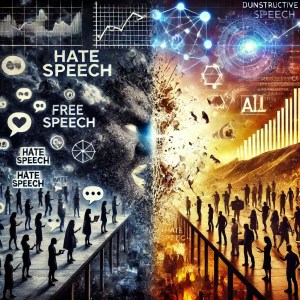TL;DR: Hate Speech Is a Manipulative Tool
Hate speech vs. free speech is a global debate, but where is the line? Hate speech isn’t just offensive—it’s a calculated strategy used to divide, provoke, and manipulate. While the U.S. emphasizes absolute free speech, Germany values both free speech and human dignity, recognizing that words have consequences. Social media platforms like TikTok amplify hate speech through algorithmic loopholes, helping bad actors manipulate public belief. Understanding how hate speech works as a tactic can help counter its effects and promote constructive dialogue instead.
The Hidden Strategy Behind Hate Speech

The battle between hate speech and free speech: Social media algorithms can amplify division, but cooperation and constructive dialogue offer a path forward.
Imagine scrolling through social media and seeing a post that instantly triggers disgust or outrage. You may feel compelled to comment, argue, or share it in disbelief. But what if your reaction was exactly what the sender intended?
Hate speech isn’t just about expressing opinions—it’s a strategic tool designed to dehumanize, provoke, and divide. It thrives on emotional manipulation, fuelling social conflict and reinforcing an “us vs. them” mentality.
Consider the phrase: “They eat dogs. They eat cats. They eat their pets.”
It doesn’t provide facts. It doesn’t spark meaningful discussion. It disgusts the audience, reducing an entire group of people to something “inhuman.” The purpose? Division, not communication.
This brings us to a central question: When does free speech cross the line into hate speech?
Free Speech vs. Hate Speech: A Cultural Divide
The debate over freedom of speech varies widely across cultures. In the United States, free speech is often seen as an absolute right, even when it includes hate speech. This perspective largely focuses on the rights of the speaker, while ignoring any right for the listener, such as protection from dehumanization or harm. The belief is that the best response to bad speech is more speech, rather than any form of restriction or intervention.
In contrast, Germany views free speech and human dignity as equally fundamental values. The country has strong historical reasons for this—after seeing how propaganda fuelled the rise of the Nazis, Germany placed legal limits on hate speech to prevent history from repeating itself. In German law, speech has consequences, and when words actively dehumanize, incite violence, or spread hate, they are not protected.
The U.S. approach prioritizes the speaker’s right, while Germany takes the dignity of the listener into account as well. This introduces a key difference: in Germany, human dignity is recognized as a fundamental right of the target of speech, creating a balance between freedom of expression and protection against harmful speech—a concept that stays largely unfamiliar in the U.S.
This global divide on free speech is playing out in real-time on social media, where platforms struggle to balance openness with responsibility. However, this struggle is also profitable—every piece of content, including hate speech, generates engagement, keeping users on the platform longer and increasing ad revenue. The question is still: Is there a true interest in combating hate speech, or does the system benefit from its presence?
How Hate Speech Manipulates Perception
Hate speech works because it is psychologically engineered to trigger strong emotions. Here’s how it manipulates perception:
🛑 Dehumanization – Reducing people to stereotypes or “subhuman” traits makes it easier to justify discrimination. (Example: “They eat dogs.”)
😡 Emotional Manipulation – Hate speech provokes disgust, fear, or anger, overriding logical thinking.
⚔️ Divide & Conquer Tactic – Hate speech enforces “us vs. them” thinking, increasing social polarization.
🎭 False Legitimacy – It often disguises itself as “just an opinion” to evade accountability.
But here’s a key question: What actual information is being communicated?
Most hate speech does not hold facts or meaningful discourse—it exists to provoke emotions rather than inform. Once you recognize this, you can start seeing through its manipulation.
Social Media: The Algorithmic Weapon
Hate speech isn’t just spread by individuals—it’s amplified by algorithms.
Platforms like TikTok, Facebook, and Twitter don’t just show content chronologically. Instead, they prioritize engagement—which means controversial, hateful, or extreme content often spreads the fastest.
🔍 Real-World Example: A 2024 report from the Institute for Strategic Dialogue (ISD) uncovered hundreds of fake TikTok accounts boosting extremist hate speech. These accounts liked, shared, and commented on each other’s content to trick TikTok’s algorithm into promoting hate speech to a wider audience.
💡 Why does this work? Social media platforms reward engagement, even when it’s negative. The more people react—whether with likes or outrage—the more the algorithm pushes the content to others.
This is a digital version of “Divide and Conquer.” By using AI-driven recommendation systems, hate speech spreads faster and wider than ever before.
The Consequences: How Hate Speech Affects Society
Hate speech has real-world consequences, both psychologically and socially:
🔸 Increased stress, anxiety, and emotional distress for targeted individuals.
🔸 Reinforces prejudice and discrimination by normalizing harmful stereotypes.
🔸 Silences voices—when hate speech becomes rampant, marginalized groups withdraw from conversations.
🔸 Threatens democracy—when public discourse is polluted with division, cooperation breaks down.
The good news? Hate speech can be countered—but it requires awareness and action.
How to Recognize & Counter Hate Speech
So, what can you do? Here are five effective ways to fight back:
✅ Recognize it as a manipulation tactic. When you see hate speech, ask: What actual information is being communicated? If the answer is “nothing,” don’t fall into the trap.
✅ Call it out for what it is. If you recognize hate speech, naming it directly— “This is hate speech”—can break the cycle of manipulation and stop its influence.
✅ Avoid reacting emotionally. Hate speech is designed to provoke—don’t give it the reaction it wants. Instead, approach with logic and composure.
✅ Report & flag hate speech. Social media platforms have tools for reporting harmful content. Use them.
✅ Promote constructive conversation. Counter hate speech by amplifying facts, inclusivity, and critical thinking rather than engaging in outrage.
Conclusion: Free Speech vs. Hate Speech, and the TPOCo Perspective
At what point does “freedom of speech” become a tool for oppression rather than expression?
Free speech is vital—but so is recognizing when it is being weaponized to silence, dehumanize, and divide.
The next time you meet hate speech, ask yourself:
❓ What is actually being communicated?
❓ Is this spreading truth, or just provoking anger?
❓ Does protecting free speech justify harm to others?
By understanding how hate speech works, we can reduce its impact and create a healthier, more cooperative society—one that aligns with the principles of TPOCo. Cooperation thrives on constructive communication, shared understanding, and mutual respect, whereas hate speech seeks to divide. The Principle of Cooperation (TPOCo) reminds us that true progress is achieved not through division but through working together to build a better future.



Leave a Reply